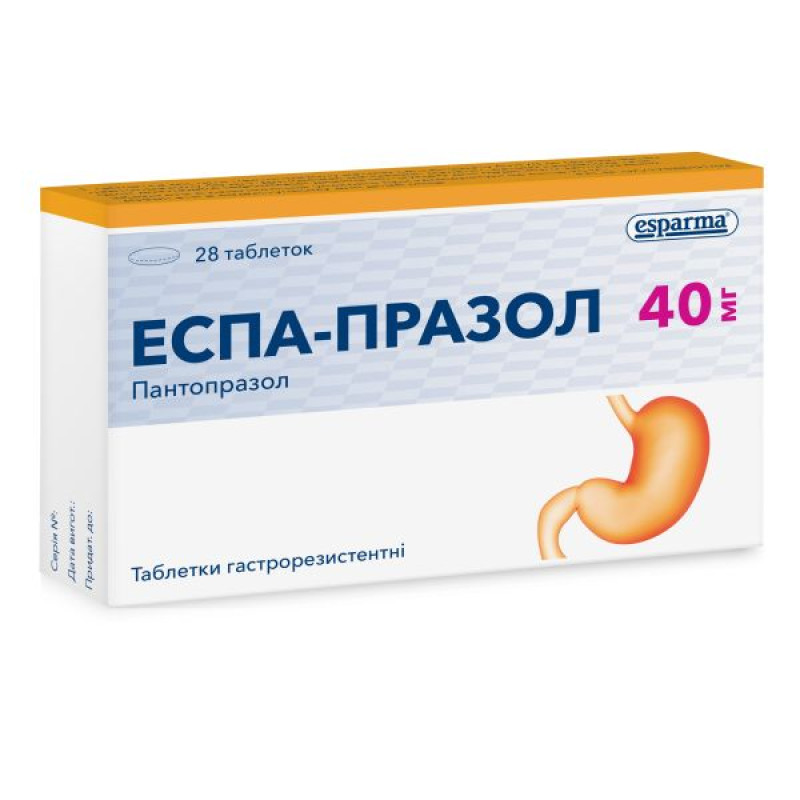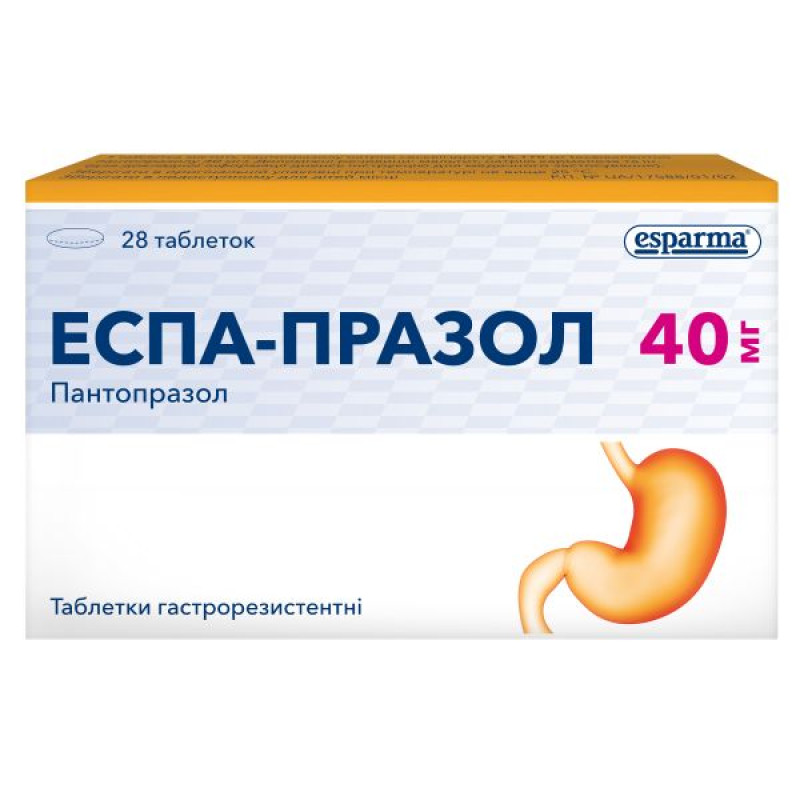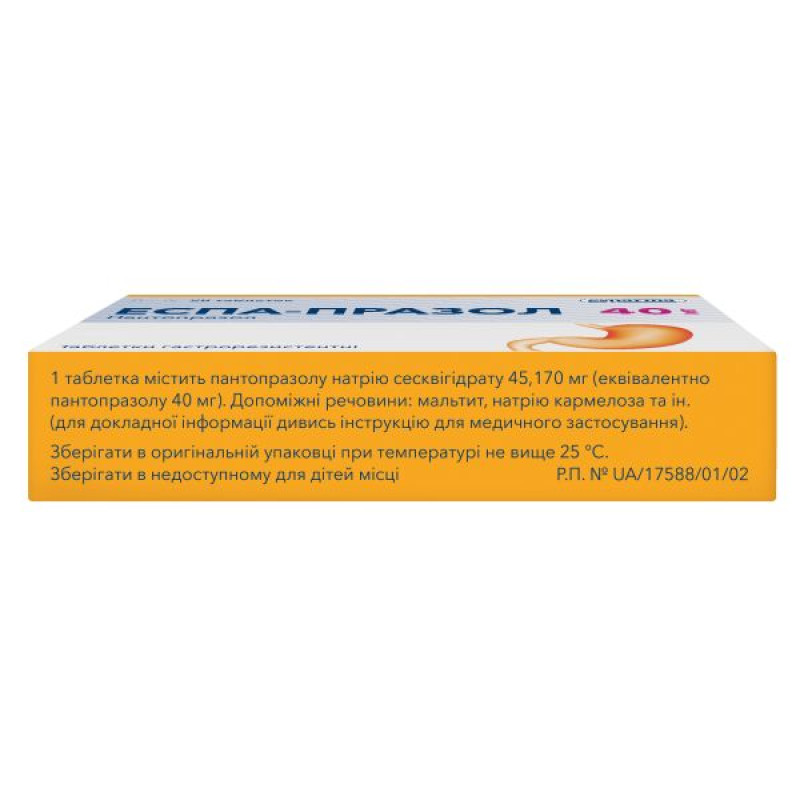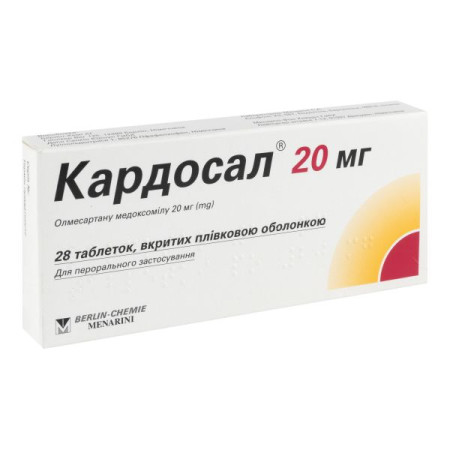Espa-prazole tablets 40 mg No. 28

Instructions for Espa-prazole tablets 40mg No. 28
Composition
active ingredient: pantoprazole;
1 tablet contains 45.17 mg of pantoprazole sodium sesquihydrate (equivalent to 40.0 mg of pantoprazole);
excipients: maltitol, anhydrous sodium carbonate, crospovidone (type B), carmellose sodium, calcium stearate;
tablet shell: Opadry II Yellow 85G52042 or similar [polyvinyl alcohol, talc, titanium dioxide (E171), macrogol 3350, lecithin, iron oxide yellow (E172)], sodium carbonate, methacrylic acid and ethyl acrylate copolymer (1:1) dispersion 30%, triethyl acetate.
Dosage form
Gastro-resistant tablets.
Main physicochemical properties: yellow, oval-shaped tablets.
Pharmacotherapeutic group
A drug for the treatment of acid-dependent diseases. Proton pump inhibitors. ATC code A02B C02.
Pharmacological properties
Pharmacodynamics
Mechanism of action. Pantoprazole is a substituted benzimidazole that inhibits gastric acid secretion by specific blockade of the proton pumps of the parietal cells. Pantoprazole is converted to its active form in the acidic environment of the parietal cells, where it inhibits the enzyme H+-K+-ATPase, i.e. blocks the final step in the production of gastric acid. The inhibition is dose-dependent and suppresses both basal and stimulated acid secretion. Most patients are relieved of symptoms within 2 weeks. The use of pantoprazole, like other proton pump inhibitors (PPIs) and H2-receptor inhibitors, reduces gastric acidity and thus increases gastrin secretion in proportion to the decrease in acidity. The increase in gastrin secretion is reversible. Since pantoprazole binds the enzyme distal to the cellular receptor, it can inhibit hydrochloric acid secretion regardless of stimulation by other substances (acetylcholine, histamine, gastrin). The effect is the same when the drug is administered orally and intravenously.
Pantoprazole increases fasting gastrin levels. In short-term use, gastrin levels do not exceed the upper limit of normal in most cases. In long-term treatment, gastrin levels increase by a factor of two in most cases. However, excessive increases occur only in isolated cases. As a result, a slight or moderate increase in specific endocrine (ECL) cells in the stomach (similar to adenomatoid hyperplasia) is sometimes observed during long-term treatment. However, according to studies conducted to date, the formation of neuroendocrine tumor precursor cells (atypical hyperplasia) or neuroendocrine tumors of the stomach, which have been identified in animal studies, has not been observed in humans.
Based on the results of animal studies, the effect of long-term (more than one year) treatment with pantoprazole on endocrine parameters of the thyroid gland cannot be completely excluded.
During treatment with antisecretory drugs, serum gastrin levels increase in response to decreased acid secretion. In addition, chromogranin A (CgA) levels increase due to decreased gastric acidity. Elevated CgA levels may interfere with diagnostic tests for neuroendocrine tumors. Available published data suggest that proton pump inhibitor treatment should be discontinued 5–14 days before CgA measurements. This allows CgA levels to return to the normal range, which may be falsely elevated after PPI treatment.
Pharmacokinetics
Absorption. Pantoprazole is rapidly absorbed and peak plasma concentrations are reached after a single oral dose of 20 mg. Peak serum concentrations of approximately 1–1.5 μg/ml are reached on average 2–2.5 hours after administration; the concentration remains constant after multiple administration. The pharmacokinetic properties do not change after single or repeated administration. In the dose range of 10 to 80 mg, the plasma pharmacokinetics of pantoprazole remain linear after both oral and intravenous administration. The absolute bioavailability of the tablets has been shown to be approximately 77%. Concomitant food intake does not affect the AUC (area under the concentration-time curve) or peak serum concentrations, and therefore the bioavailability. Only the variability of the latent period increases with concomitant food intake.
Distribution: The binding of pantoprazole to serum proteins is about 98%. The volume of distribution is about 0.15 l/kg.
Biotransformation. The substance is metabolized almost exclusively in the liver. The main metabolic pathway is demethylation by CYP2C19 followed by sulfate conjugation; other metabolic pathways include oxidation by CYP3A4.
The main part of the metabolites of pantoprazole is excreted in the urine (about 80%), the rest is excreted in the feces. The main metabolite in both serum and urine is desmethylpantoprazole, conjugated with sulfate. The half-life of the main metabolite (about 1.5 hours) is slightly longer than that of pantoprazole.
Special patient groups.
Poor metabolisers. Approximately 3% of Europeans have a low functional activity of the CYP2C19 enzyme; they are called poor metabolisers. In these individuals, the metabolism of pantoprazole is probably mainly catalysed by the CYP3A4 enzyme. After a single dose of 40 mg pantoprazole, the mean area under the plasma concentration-time curve was approximately 6 times larger in poor metabolisers than in subjects with a functionally active CYP2C19 enzyme (extensive metabolisers). The mean peak plasma concentration was increased by approximately 60%. These findings do not affect the posology of pantoprazole.
Renal impairment. There are no recommendations for dose reduction when prescribing pantoprazole to patients with impaired renal function (including patients on dialysis). As in healthy subjects, the elimination half-life of pantoprazole is short. Only very small amounts of pantoprazole are dialysable. Although the main metabolite has a moderately long elimination half-life (2–3 hours), elimination is still rapid, so accumulation does not occur.
Hepatic impairment: Although in patients with cirrhosis (Child-Pugh class A and B) the half-life increases to 3-6 hours and the AUC increases 3-5-fold, the maximum serum concentration increases only slightly, by 1.3-fold, compared with that in healthy volunteers.
Elderly patients: The slight increase in AUC and Cmax in elderly volunteers compared to younger volunteers is also not clinically relevant.
Children: After a single oral dose of 20 or 40 mg pantoprazole, AUC and Cmax in children aged 5 to 16 years were within the range of the corresponding values in adults. After a single intravenous administration of pantoprazole at doses of 0.8 or 1.6 mg/kg to children aged 2 to 16 years, there was no significant relationship between the clearance of pantoprazole and the patient's age or body weight. The AUC and volume of distribution were consistent with those obtained in studies in adults.
Indication
Adults and children aged 12 and over.
Reflux esophagitis.
Adults.
Eradication of Helicobacter pylori (H. pylori) in patients with H. pylori-associated gastric and duodenal ulcers in combination with appropriate antibiotics.
Duodenal ulcer.
Stomach ulcer.
Zollinger-Ellison syndrome and other hypersecretory pathological conditions.
Contraindication
Hypersensitivity to the active substance, benzimidazole derivatives or any auxiliary component of the medicinal product.
Interaction with other medicinal products and other types of interactions
Medicinal products whose absorption is pH-dependent: Due to the complete and long-term inhibition of hydrochloric acid secretion, pantoprazole may affect the absorption of medicinal products for which the pH of the gastric juice is an important factor in their bioavailability (e.g. some antifungals such as ketoconazole, itraconazole, posaconazole, or other medicinal products such as erlotinib).
HIV protease inhibitors: Concomitant use of pantoprazole with HIV protease inhibitors (such as atazanavir) whose absorption is dependent on intragastric pH is not recommended due to a significant reduction in their bioavailability (see section 4.4).
In cases where concomitant use of HIV protease inhibitors with proton pump inhibitors cannot be avoided, close clinical monitoring (e.g. viral load) is recommended. The daily dose of pantoprazole should not exceed 20 mg. Dose adjustment of HIV protease inhibitors may be necessary.
Coumarin anticoagulants (phenprocoumon and warfarin). Concomitant use of pantoprazole with warfarin or phenprocoumon did not affect the pharmacokinetics of warfarin, phenprocoumon or INR (international normalized ratio). However, increases in INR and prolongation of prothrombin time have been reported in patients receiving concomitant PPIs and warfarin or phenprocoumon. Increases in INR and prolongation of prothrombin time may lead to pathological bleeding and even death. In such concomitant use, INR and prothrombin time should be monitored.
Other interactions. Pantoprazole is extensively metabolised in the liver via the cytochrome P450 enzyme system. The main route of metabolism is demethylation by CYP2C19 and other metabolic pathways, including oxidation by CYP3A4. Studies with medicinal products also metabolised by these pathways, such as carbamazepine, diazepam, glibenclamide, nifedipine and oral contraceptives containing levonorgestrel and ethinylestradiol, have not revealed any clinically significant interactions.
Interactions of pantoprazole with other drugs that are metabolized through the same enzyme system cannot be excluded.
The results of a number of studies on possible interactions indicate that pantoprazole does not affect the metabolism of active substances metabolized by CYP1A2 (e.g. caffeine, theophylline), CYP2C9 (e.g. piroxicam, diclofenac, naproxen), CYP2D6 (e.g. metoprolol), CYP2E1 (e.g. ethanol), and does not affect p-glycoprotein, which is associated with the absorption of digoxin.
No interactions with concomitantly administered antacids were identified.
Studies of the interaction of pantoprazole with certain antibiotics (clarithromycin, metronidazole, amoxicillin) administered concomitantly have been conducted. No clinically significant interactions between these drugs have been identified.
Medicinal products that inhibit or induce CYP2C19. CYP2C19 inhibitors, such as fluvoxamine, may increase the systemic exposure of pantoprazole. A dose reduction should be considered in patients receiving long-term treatment with high doses of pantoprazole and in patients with impaired liver function. Inducers of enzymes that affect CYP2C19 and CYP3A4, such as rifampicin and St. John's wort (Hypericum perforatum), may reduce plasma concentrations of PPIs that are metabolised by these enzyme systems.
Drug Interactions with Laboratory Tests: False-positive results of some urine screening tests for THC have been reported in patients taking pantoprazole. Alternative testing methods should be considered to confirm the results.
Application features
Hepatic impairment: In patients with severe hepatic impairment, liver enzyme levels should be monitored regularly, especially during long-term treatment. If liver enzyme levels increase, treatment with the drug should be discontinued (see section 4.2).
Concomitant use with NSAIDs. The drug Espa-prazole®, 40 mg tablets, should be used for the prevention of gastric and duodenal ulcers resulting from long-term use of NSAIDs only in patients who are prone to frequent exacerbations of gastric and duodenal ulcers.
Risk assessment is based on individual factors, including age (> 65 years), history of gastric or duodenal ulcer, and gastrointestinal bleeding.
Gastric malignancies. Symptomatic response to pantoprazole may mask symptoms of gastric malignancies and delay their diagnosis. In case of alarming symptoms (e.g. significant weight loss, recurrent vomiting, dysphagia, haematemesis, anaemia, melena), as well as in the presence or suspicion of gastric ulcer, malignancy should be excluded.
If symptoms persist despite adequate treatment, further examination is necessary.
HIV protease inhibitors: Concomitant use of pantoprazole with HIV protease inhibitors (such as atazanavir) whose absorption is dependent on intragastric pH is not recommended due to a significant reduction in their bioavailability (see section 4.5).
Vitamin B12 absorption: Pantoprazole may reduce the absorption of vitamin B12 (cyanocobalamin) due to the occurrence of hypo- and achlorhydria. This should be taken into account in patients with low body weight or in the presence of factors that reduce the absorption of vitamin B12 during long-term treatment, or in the presence of relevant clinical symptoms.
Long-term treatment. With long-term treatment, especially more than 1 year, patients should be under regular medical supervision.
Gastrointestinal infections caused by bacteria. Treatment with Espa-prazole® slightly increases the risk of gastrointestinal infections caused by bacteria such as Salmonella and Campylobacter or C. Difficile.
In patients requiring long-term therapy and in patients taking PPIs concomitantly with digoxin or drugs that may cause hypomagnesemia (e.g., diuretics), magnesium levels should be determined before starting PPI treatment and periodically during treatment.
Bone fractures. Long-term treatment (more than 1 year) with high doses of proton pump inhibitors modestly increases the risk of hip, wrist, and spine fractures, mainly in the elderly or in the presence of other risk factors. Observational studies suggest that the use of proton pump inhibitors increases the overall risk of fractures by 10–40%. Some of these may be due to other risk factors. Patients at risk of osteoporosis should be treated according to current clinical guidelines and consume adequate amounts of vitamin D and calcium.
Severe cutaneous adverse reactions. Severe cutaneous adverse reactions, which can be life-threatening or fatal, have been reported with pantoprazole, including erythema multiforme, Stevens-Johnson syndrome, toxic epidermal necrolysis and drug reaction with eosinophilia and systemic symptoms (DRESS). The frequency of these reactions is unknown (see section 4.8). Patients should be informed of the signs and symptoms and monitored closely. If symptoms suggestive of these reactions occur, pantoprazole should be discontinued immediately and alternative treatment should be considered.
Subacute cutaneous lupus erythematosus. The use of proton pump inhibitors has been associated with very rare cases of subacute cutaneous lupus erythematosus. If lesions occur, especially in areas exposed to sunlight, and this is accompanied by arthralgia, the patient should immediately consult a doctor who will consider the need to discontinue the use of the drug Espa-prazole®. The occurrence of subacute cutaneous lupus erythematosus in patients during previous therapy with proton pump inhibitors increases the risk of its development with the use of other proton pump inhibitors.
Effect on laboratory test results. Elevated chromogranin A (CgA) levels may interfere with the diagnostic tests for neuroendocrine tumors. To avoid this effect, treatment with Espa-prazole® should be temporarily discontinued for at least 5 days prior to CgA measurement (see section 5.2). If CgA and gastrin levels have not returned to the normal range after initial measurement, repeat measurements should be performed 14 days after discontinuation of proton pump inhibitor treatment.
Sodium: This medicinal product contains less than 1 mmol sodium (23 g) per tablet, i.e. essentially sodium-free.
Use during pregnancy or breastfeeding
Pregnancy. Available data on the use of Espa-prazole® in pregnant women (approximately 300-1000 pregnancy outcomes) indicate no embryonal or foeto/neonatal toxicity of the drug. Reproductive toxicity has been observed in animal studies. As a precautionary measure, the use of Espa-prazole® in pregnant women should be avoided.
Breastfeeding. Animal studies have shown excretion of pantoprazole in breast milk. There is insufficient data on the excretion of pantoprazole in human milk, but such excretion has been reported. A risk to the newborn/infants cannot be excluded. A decision must be made whether to discontinue breast-feeding or to discontinue/abstain from Espa-prazole® therapy taking into account the benefit of breast-feeding for the child and the benefit of Espa-prazole® therapy for the woman.
Fertility: Pantoprazole did not impair fertility in animal studies.
Ability to influence reaction speed when driving vehicles or other mechanisms
Pantoprazole has no or very minor influence on the ability to drive or use machines. It is necessary to take into account the possible development of side effects such as dizziness and visual disturbances (see section "Adverse reactions"). In such cases, you should not drive or use machines.
Method of administration and doses
Espa-prazole®, gastro-resistant tablets, should be taken 1 hour before meals whole, do not chew or crush, and washed down with water.
Adults and children aged 12 and over.
Treatment of reflux esophagitis.
The recommended dose is 1 tablet of Espa-prazole® 40 mg per day. In some cases, the dose can be doubled (2 tablets of Espa-prazole® 40 mg per day), especially if other drugs for the treatment of reflux esophagitis are ineffective. Reflux esophagitis usually takes 4 weeks to treat. If this is not enough, recovery can be expected within another 4 weeks.
Adults.
In adult patients with gastric and duodenal ulcers and positive H. pylori test results, eradication of the organism should be achieved with combination therapy. Local data on bacterial resistance and current guidelines for the use and prescription of appropriate antibacterial agents should be taken into account. Depending on susceptibility, the following therapeutic combinations may be used for eradication of H. pylori in adults:
a) 1 tablet of the drug Espa-prazole® 40 mg 2 times a day
+ 1000 mg of amoxicillin 2 times a day
+ 500 mg of clarithromycin 2 times a day;
b) 1 tablet of the drug Espa-prazole® 40 mg 2 times a day
+ 400–500 mg metronidazole (or 500 mg tinidazole) 2 times a day
+ 250–500 mg of clarithromycin 2 times a day;
c) 1 tablet of the drug Espa-prazole® 40 mg 2 times a day
+ 1000 mg of amoxicillin 2 times a day
+ 400–500 mg of metronidazole (or 500 mg of tinidazole) 2 times a day.
When using combination therapy for the eradication of H. pylori, the second tablet of Espa-prazole® 40 mg should be taken in the evening 1 hour before a meal. The duration of treatment is 7 days and can be extended for another 7 days. The total duration of treatment is no more than two weeks. If further treatment with pantoprazole is indicated to ensure ulcer healing, the dosage recommendations for gastric and duodenal ulcers should be considered. If combination therapy is not indicated, for example in patients with a negative test result for H. pylori, Espa-prazole® 40 mg is used for monotherapy in the dosage indicated below.
Treatment of stomach ulcers.
1 tablet of Espa-prazole® 40 mg per day. In some cases, the dose can be doubled (2 tablets of Espa-prazole® 40 mg per day), especially if there is no effect from the use of other drugs.
It usually takes 4 weeks to heal a stomach ulcer. If this is not enough, healing of the ulcer can be expected within another 4 weeks.
Treatment of duodenal ulcers.
1 tablet of Espa-prazole® 40 mg per day. In some cases, the dose can be doubled (2 tablets of Espa-prazole® 40 mg per day), especially if there is no effect from the use of other drugs.
Duodenal ulcers usually take 2 weeks to heal. If this is not enough, healing of the ulcer can be expected within another 2 weeks.
Treatment of Zollinger-Ellison syndrome and other hypersecretory pathological conditions. For long-term treatment of Zollinger-Ellison syndrome and other pathological hypersecretory conditions, the initial daily dose is 80 mg (2 tablets of Espa-prazole® 40 mg). If necessary, the dose can then be titrated up or down, depending on the acidity of the gastric juice. A dose exceeding 80 mg per day should be divided into two doses. A temporary increase in the dose to more than 160 mg of pantoprazole is possible, but the duration of use should be limited only to the period necessary for adequate acidity control.
The duration of treatment for Zollinger-Ellison syndrome and other pathological conditions is not limited and depends on clinical need.
Liver dysfunction. Patients with severe liver dysfunction should not exceed a dose of 20 mg (1 tablet of Espa-prazole® 20 mg) per day.
The drug Espa-prazole® should not be used for the eradication of H. pylori in combination therapy in patients with moderate and severe liver dysfunction, as there is currently no data on the efficacy and safety of such use in this category of patients.
Renal impairment. Patients with renal impairment do not require dose adjustment. Espa-prazole® should not be used for the eradication of H. pylori in combination therapy in patients with renal impairment, as there is currently no data on the efficacy and safety of such use in this category of patients.
Elderly patients do not require dose adjustment.
Children
Espa-prazole® 40 mg is indicated in children aged 12 years and older for the treatment of reflux esophagitis. The drug is not recommended for use in children under 12 years of age, as data on the safety and efficacy of the drug in this age group are limited.
Overdose
Symptoms of overdose are unknown.
Doses up to 240 mg administered intravenously over 2 minutes have been well tolerated. Since pantoprazole is extensively protein bound, it is not a drug that can be readily dialyzed.
In case of overdose with clinical signs of intoxication, symptomatic and supportive therapy is used. There are no specific therapy recommendations.
Side effects
Adverse reactions can be expected to occur in approximately 5% of patients. The most common adverse reactions are diarrhea and headache (occurring in approximately 1% of patients).
Adverse effects are classified by frequency of occurrence into the following categories: very common (≥ 1/10), common (≥ 1/100 and < 1/10), uncommon (≥ 1/1000 and < 1/100), rare (≥ 1/10000 and < 1/1000), very rare (< 1/10000), unknown (frequency not determined based on available data).
Within each frequency category, adverse reactions are presented in order of decreasing seriousness.
From the blood and lymphatic system.
Rare: agranulocytosis.
Very rare: leukopenia, thrombocytopenia, pancytopenia.
From the immune system.
Rare: hypersensitivity reactions (including anaphylactic reactions, anaphylactic shock).
Metabolism and metabolic disorders.
Rare: hyperlipidemia and increased lipid levels (triglycerides, cholesterol), changes in body weight.
Not known: hyponatremia, hypomagnesemia (see section "Special warnings and precautions for use"), hypocalcemia1, hypokalemia.
Mental disorders.
Uncommon: sleep disorders.
Rare: depression (including exacerbation).
Very rare: disorientation (including exacerbation).
Not known: hallucination, confusion (especially in patients with a predisposition to such disorders, as well as exacerbation of these symptoms in case of pre-existing conditions).
From the nervous system.
Uncommon: headache, dizziness.
Rare: taste disorders.
Not known: paraesthesia.
From the organs of vision.
Rare: visual disturbances/blurred vision.
From the digestive tract.
Common: fundal gland polyps (benign).
Uncommon: diarrhoea, nausea, vomiting, abdominal bloating, constipation, dry mouth, abdominal pain and discomfort.
Not known: microscopic colitis.
On the part of the hepatobiliary system.
Uncommon: increased liver enzymes (transaminases, γ-glutamyltransferase).
Rare: increased bilirubin levels.
Not known: hepatocyte damage, jaundice, hepatocellular failure.
On the skin and subcutaneous tissue.
Uncommon: skin rash, exanthema, pruritus.
Rare: urticaria, angioedema.
Not known: Stevens-Johnson syndrome, Lyell's syndrome (toxic epidermal necrolysis), drug reaction with eosinophilia and systemic symptoms (DRESS syndrome), erythema multiforme, photosensitivity, subacute cutaneous lupus erythematosus (see section "Special warnings and precautions for use").
On the part of the musculoskeletal system and connective tissue.
Uncommon: fractures of the hip, wrist, spine (see section "Special warnings and precautions for use").
Rare: arthralgia, myalgia.
Not known: muscle spasm2.
On the part of the kidneys and urinary system.
Not known: interstitial nephritis (with possible development of renal failure).
From the reproductive system and mammary glands.
Rare: gynecomastia.
General disorders.
Uncommon: asthenia, fatigue, malaise.
Rare: fever, peripheral edema.
1 Hypocalcemia and/or hypokalemia may be associated with the development of hypomagnesemia (see section "Special warnings and precautions for use")
2 Muscle spasm due to electrolyte imbalance.
Reporting of suspected adverse reactions.
Reporting adverse reactions after registration of a medicinal product is of great importance. This allows monitoring of the benefit/risk ratio of the medicinal product. Medical and pharmaceutical professionals, as well as patients or their legal representatives, should report all cases of suspected adverse reactions and lack of efficacy of the medicinal product via the automated pharmacovigilance information system (https://aisf.dec.gov.ua).
Expiration date
Blisters made of aluminum foil on both sides - 60 months.
Blisters made of aluminum foil on one side and PVC/PE/PVdC film on the other side - 30 months.
Storage conditions
Store in original packaging at a temperature not exceeding 25 ° C. Keep out of the reach of children!
Packaging
14 tablets in a blister (aluminum foil on both sides or aluminum foil on one side and PVC/PE/PVdC film on the other), 1 or 2 blisters in a cardboard box.
Vacation category
According to the recipe.
Producer
Advance Pharma GmbH, Germany.
Location of the manufacturer and its business address: Wallenroder Str. 8 - 14, 13435, Berlin, Germany.
There are no reviews for this product.
There are no reviews for this product, be the first to leave your review.
No questions about this product, be the first and ask your question.














